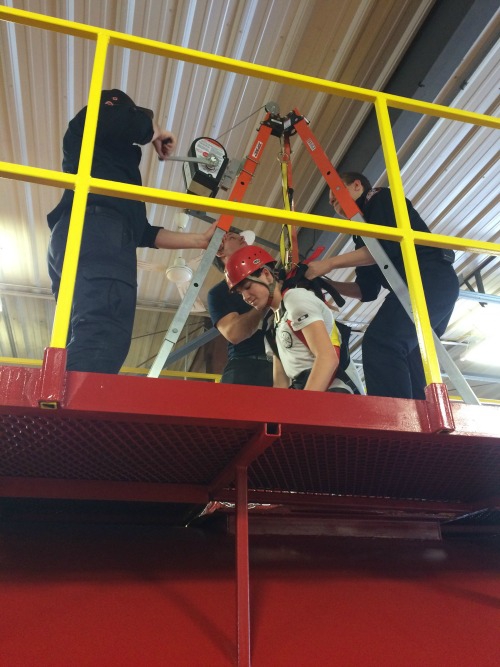
Equipment
Guest Column: March 2016
Training props are something fire services want and need, but unfortunately not always something they can afford. Getting money from the federal or provincial government seems logical, but that means competing with other departments in your own municipality. What if there are other ways to amass training supplies? The Lesser Slave Regional Fire Service has come up with a few solutions that are worth sharing.
February 24, 2016
By Jamie Coutts
 Firefighters with Lesser Slave Regional Fire Service in Alberta capitalized on partnerships within their community to access training props during the winter months. Firefighters with Lesser Slave Regional Fire Service in Alberta capitalized on partnerships within their community to access training props during the winter months. By Jaime Coutts
Firefighters with Lesser Slave Regional Fire Service in Alberta capitalized on partnerships within their community to access training props during the winter months. Firefighters with Lesser Slave Regional Fire Service in Alberta capitalized on partnerships within their community to access training props during the winter months. By Jaime CouttsA common problem for us here in the frozen north of Alberta is accessing hands-on, useable training in the cold, winter months. In 2016 we vowed to try harder to find applicable training for our firefighters and to introduce new props and concepts.
Just after the Christmas break we called our friends at a local safety supply and service company and asked if we could use their confined-space prop again this year. Just like these good people had done for the past 14 years, they agreed and said they would not charge us. We used a loader and dragged the prop into our fire hall to let it thaw out. Based on that relationship, we began to think of new partnership possibilities. We asked the principles of Slave Safety Supply if they wanted to partner with us – they would maintain ownership of the $40,000 prop, we would supply the upgrades, paint the tank, and store it at our training site, and both of us could use it year round. The local welding company donated some of the time and materials to upgrade the prop, another local tank-building company donated a tank truck hatch, and the Slave Lake Firefighters Society covered the additional $5,000. The regional fire service provided the paint and the firefighter labour to complete the project.
This prop now can be used by local municipalities, the fire service, and industrial customers for manhole-sewer and storm-sewer training, rescue-tripod training, dangerous-goods pumping and fluid recovery, leak containment, confined-space use and rescue, and as a smoke maze. This partnership has allowed for a single-use training aid to become a versatile, multi-use, indoor-outdoor prop at a fraction of the price of a new one.
During the partnership process people heard about what was going on and tried to help us at every turn. The next idea came from one of the owners at Slave Safety Supply. WCSS (Western Canadian Spill Services) built a tanker rollover prop a few years ago and rarely had requests for its use. WCSS staff are mostly pipeline-spill responders and had built this prop to show people how to recover fluid from rolled over, or damaged tank trucks. The idea was to pass this prop on to someone who would use it, and could deliver training if requests came up. The Slave Lake Firefighters Society paid for the trucking costs (which were partly reduced by a local trucking company) and we had another prop on which to train. After painting, a few repairs and some welding, we had ourselves another great training aid. This prop is used for hatch-cone recovery training; it has two drill plates for drilling-and-recovery operations training, and is a three-part confined-space prop as well. The prop is a damaged tank from a tank truck – it has the valving, baffles, hatches and parts so the training is amazing and could not be more realistic.
The third prop came just days later when we received a letter from the provincial government granting our funding application from six months earlier. We received $40,000 for a technical rescue, high-angle addition to our training facility ($20,000 from the Government of Alberta, $15,000 from the Slave Lake Firefighters Society, $5,000 donation in-kind from the fire service). The prop will include a ladder to the top of the 16-metre (54-foot) tower with the same safety system used by the local forestry towers, service rigs, and wood mills. Our high-angle members will be able to train on realistic props and systems for rescue, rappelling and Stokes-basket work on both the inside and outside of the tower. This prop will enable all our protective-services partners and industry customers to train at a safe, offsite location so they don’t have to use existing infrastructure in their own facilities, which are often live, loud and dangerous areas that don’t lend themselves well to training scenarios.
For the firefighters and personnel from our technical teams, these three new training aids, and the new partnerships, will allow for hands-on, practical training never before seen in this area. We created these amazing opportunities by fundraising, developing partnerships and applying for government funds. It amazes me every day how the best things get done when people set aside their problems, personalities and egos and work for a common useful outcome. I could not be more proud of the communities in which we work and live.
Jamie Coutts is the fire chief of Lesser Slave Regional Fire Service in Alberta. Contact him at jamie@slavelake.ca and follow him on Twitter @chiefcoutts
Print this page